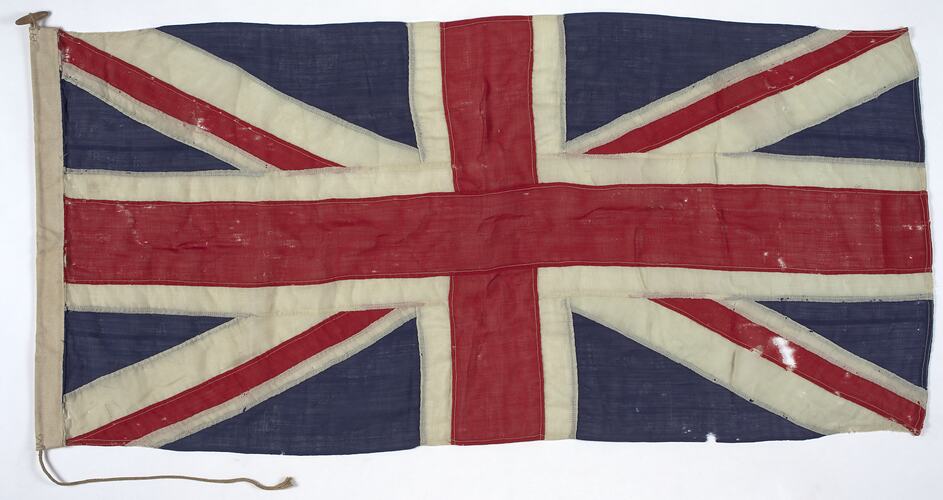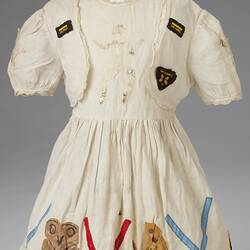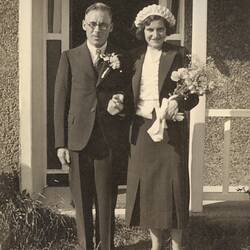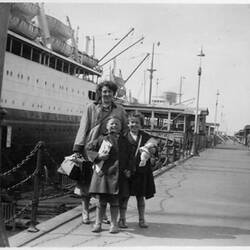Summary
Union Jack flag used by the Hathaway family during the Victory in Europe street party celebrations in Coventry, England on 8 May 1945. The flag was amongst many personal items brought to Australia when the Hathaway family migrated in 1951. Victory in Europe Day commemorates 8 May 1945, when the World War II Allies formally accepted the unconditional surrender of the armed forces of Germany. On that day celebrations took place across Europe and North America; in London over a million people celebrated the end of the European war.
Stanley and Lucy (nee Simmons) Hathaway and their daughter Hazel survived World War II in heavily bombed Coventry, England, remaining there until 1946. They attended the Victory in Europe Day (VE Day) celebrations there on 8 May 1945. The Hathaway's relocated to Buckinghamshire (where second daughter Merle was born in 1948) and Hampshire between 1946 and 1951, finally deciding to migrate to Australia. They applied successfully to the Assisted Passage Migration Scheme but had to wait two years before departing, living and touring England in a caravan until departing on the 'New Australia' 17 November, 1951. They first stayed at the Bathurst Migrant Camp in New South Wales before being relocated to a housing commission estate in Ballarat, Victoria. Within six months they had purchased a block of land, living in a caravan while their house was built. The family became active members of the local Ballarat community, with Lucy working for the newly established McCallum House Centre for Retarded Children at Sebastopol and continued her strong interest in the Brownies and Girl Guides associations.
Physical Description
Blue, off white and red textile flag constructed from separate pieces of open weave coloured fabric, stitched together with white thread to form a Union Jack design. Canvas binding along left hand side, housing a woven cord. Securing ties on the left hand top and bottom corner. Wooden toggle on top left corner. Flag is fragile with losses, signs of previous insect activity.
Significance
This collection represents the experiences of thousands of post-war assisted migrants from England who brought with them memories of danger, sadness, courage, austerity and celebration in both tangible and intangible forms. This family survived one of the most severe bombings of any English city during World War II and brought with them material symbols of endurance and triumph in the Victory Day dress and Union Jack flag, symbols with almost universal resonance. The collection also includes items which tell stories about the goods migrants select in order to start new lives, the adventure of the ship voyage, and the seeking of familiar interests in a new community. The collection also explores the theme of maintaining connections and loyalties to homeland, in this case through memorabilia relating to the British monarchy and exchange projects with former local communities.
More Information
-
Collecting Areas
Migration & Cultural Diversity, Clothing & Textiles, Public Life & Institutions
-
Acquisition Information
Donation from Merle Hathaway, 28 May 2010
-
User
Mrs Lucy J. Hathaway, Coventry, England, Great Britain, 8 May 1945
-
User
Hazel Hathaway, Coventry, England, Great Britain, 8 May 1945
-
User
Stanley Hathaway, Coventry, England, Great Britain, 8 May 1945
-
Classification
-
Category
-
Discipline
-
Type of item
-
Overall Dimensions
1340 mm (Width), 640 mm (Height)
-
Other Dimensions
1100 mm (Length)
Cord and toggle.
-
Keywords
British Immigration, Brought Goods, Celebrations, Flags, Migration & Settlement, World War II, 1939-1945, Migrant Camps, Migrant Reception Centres



